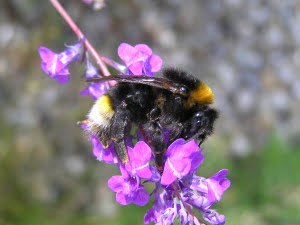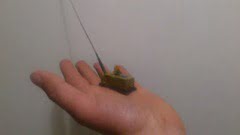
A gardener at a Dublin park has rediscovered a bumblebee species last recorded in Ireland in 1926.
Eddie Hill, who is an avid bee recorder, and regularly submits bee sightings to the National Bumblebee Monitoring scheme, noticed some odd looking bees feeding on flowers at St. Enda’s Park in Rathfarnam. After studying photographs and two specimens of the bees, experts Dr. Tomás Murray and Dr. Úna Fitzpatrick from the National Biodiversity Data Centre were able to confirm that they were the Southern cuckoo bumblebee, which was last recorded in Ireland 88 years ago.
“I’ve been interested in bumblebees for the past two years after learning how to identify them at a National Bumblebee Monitoring Scheme workshop. With my work, I’m in St. Enda’s most days, so when I saw these bees pollinating flowers in the park, I just knew they were different,” said Eddie.
It’s a significant discovery according to ecologist Dr. Tomás Murray, who is project coordinator for the National Bumblebee Monitoring Scheme.
“Overall, 30% of the 102 species of bee are endangered and, given how long it’s been since this bee was recorded, we thought we’d never see it again. Our recorders in the monitoring scheme have been passing on photos of suspected sightings, so we did get a little excited when we received Eddie’s photos, but were delighted when we confirmed it was the Southern cuckoo bumblebee, Bombus vestalis.”
Renowned entomologist Arthur Wilson Stelfox, working for the National Museum in Dublin, was the last person to record the speciesnear Bagenalstown, Co. Carlow in 1926.
“Like other cuckoo bees, it’s unusual in the sense that it doesn’t make its own nest, but invades a host bee’s nest, kills the queen, then uses the host workforce to rear its young. Being what is known as a ‘social parasite’, it will always have a much lower population size than its host, making it more vulnerable to extinction.”, explained Dr Murray. “So it could be that it almost died out, but is now expanding again, or that it has simply been rare, but overlooked as, up until the National Bumblebee Monitoring Scheme, there haven’t been enough skilled people looking for it.”
The site where the discovery was made, St. Enda’s Park, is run by the Office of Public Works, and is home to the Pádraig Pearse Museum, a visitor centre and a nature study room set in nearly 50 acres of parkland that supports a variety of flora and fauna.
This discovery highlights how important green spaces in urban areas can be for wildlife, especially our beleaguered pollinators, and Eddie Hill is determined to document as many as he can.
“I’ve successfully roped many of my colleagues in work into photographing insects for me, so now that I have found such a lovely rare bumblebee, we’ve all been given a boost to go out and try to record a good few more species for the Data Centre!” he said.










2 comments
Susan lynch
Next open day for identification purposes please – I am a small commercial flower grower and would be interested in keeping records
Calvin Jones
Hi Susan,
The National Biodiversity Data Centre run annual identification workshops covering various groups of plants and animals. I’m not sure when the next pollinator / bumblebee workshop is — check out their events page here. It’s also worth checking their Irish Pollinator Initiative page, which has lots of great info on their recording scheme, downloadable identification guides, species accounts and much more.
Best of luck with it!